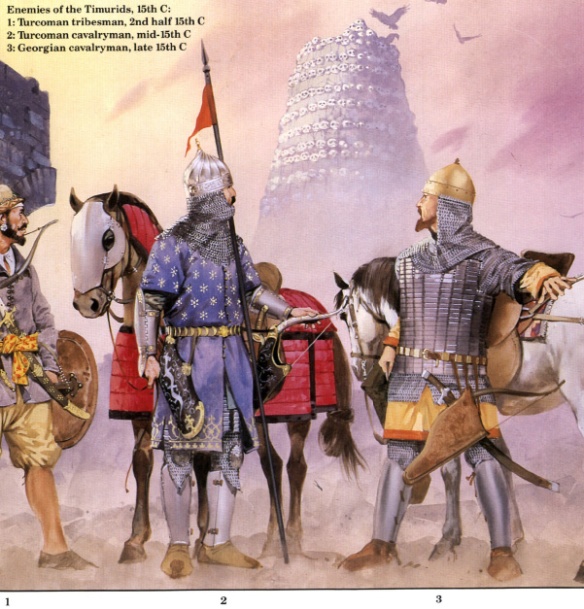Turkish Warriors
Tamerlane
Tamerlane, the English name for Timur Leng (“Timur the Lame”) (1336-1405), is often regarded as a reincarnation of Genghis (Jenghiz, Chinggis) Khan (1167?-1227), but he was a Turk of the Barlas clan, not a Mongol; a conservative Muslim, he was, not like Genghis, tolerant of other religions, and, though intellectually vigorous and illiterate like Genghis, he was too impatient to be concerned with civil administration. Raised as a Turkish chief’s son in the traditions of the recently defunct (1335) Il-Khan Empire, Tamerlane inherited Mongol approaches to military strategy and the manipulation of adversaries, making the Turks into an experienced, disciplined force for brutal conquest. He is well known for the Mongol-like barbarity of his wars, begun while he was still in his mid-20s. Then vizier (high Muslim official) to the White Horde (Chagatai Khanate), he directed its conquest of Transoxania (presently Uzbekistan) and Turkistan (region in central Asia extending from the Caspian Sea to the Gobi Desert). By 1369, Tamerlane had become supreme leader of the Turkish tribes, and under his command, the Muslims regained their military superiority, bloodily finishing his wars in Transoxania. He took control of the White Horde khanate in 1375, conquered three-quarters of their land by 1380, and then ruthlessly subdued Persia to the Euphrates River by 1387.
These conquests were interrupted by TAMERLANE’S FIRST WAR AGAINST TOKTAMISH, whom he had installed as khan (leader) during the GOLDEN HORDE DYNASTIC WAR. In 1392, Tamerlane’s forces crossed the Euphrates to establish control of Georgia and Azerbaijan and the southern Russian states (the Crimean Tatars felt his strength during TAMERLANE’S SECOND WAR AGAINST TOKTAMISH). Afterward he returned to Samarkand, the capital of the Timurid Empire, but, as was his habit, stayed there only briefly to plan and begin his invasion of India, during which he ravaged Delhi. Returning to Samarkand with Indian treasures, he next ravaged Georgia again after defeating Lithuania’s Duke Witold (Vytautus) (1350-1430). Like the Mongols, his forces advanced toward the Mediterranean, seizing Baghdad, Damascus, and Aleppo from the Mamluk Turks by 1400. In the Ottoman Empire, Tamerlane defeated Bayazid I (1347, 1403), Ottoman sultan and conqueror of Asia Minor, at the 1402 Battle of ANGORA. Now 66, Tamerlane returned to Samarkand, planned with careful detail an invasion of China, but died en route in 1405. His dynasty (the Timurids) lasted for a century, dedicating more to the advancement of scholarship, science, and art than to military activities.
Tamerlane’s Invasion of India (1398-99)
Like Genghis (Jenghiz, Chinggis) Khan (1167?- 1227), Tamerlane (Timur) (1336-1405), the Turkish- Mongol leader, seldom made war without a public motive. Ostensibly, he was now reacting against the city of Delhi’s over-kindness to non-Muslims; actually, he was taking advantage of dynastic controversy over its sultanate and Muslim-Hindu battles throughout India. Also, in accord with Mongol tradition, his invading troops entered India through Afghanistan, built a boat bridge to cross the Indus River, and plundered the Punjab during a leisurely march to the east. Tamerlane’s goal was Delhi and its riches. The city was not besieged. His troops won a battle outside it (December 17, 1398) and took many prisoners; Tamerlane entered in triumph, was enthroned after one day, and collected ransom money. But conditions soon deteriorated: his soldiers looted and raped with abandon; Indian prisoners were taken and executed-as were those from the Battle of Delhi-to an estimated total of 50,000 to 80,000. Delhi was then burned. After 10 days, the conquerors left unhurriedly, hauling wagonloads of treasure with captured artisans to build Samarkand’s now ruined cathedral mosque. Pillaging en route, they laid waste to Lahore, recrossed the Indus, and returned home. Delhi, a devastation ground, now contended with plague and famine (its historians note that nothing moved for two months). However, the tradition of Tamerlane, who had gained wealth and eliminated an enemy in his planned campaign against China, lived on in northern India; his great-grandson Babur (1483-1530) founded the great Mogul dynasty in 1526.
Tamerlane’s Invasion of Russia (1391-95)
After his first battle (1391) with his foe Toktamish (Tuqtamish) (d. 1406) in the second punitive war, Tamerlane (Timur) (1336-1405) seized the city of Sarai, the capital of the Golden Horde (Kipchak Khanate), partially sacking it. Ever restless, Tamerlane led his 100,000-man army into Russia, conquering the city of Yelets, but stopping about 200 miles from Moscow. Instead of advancing, until 1395, Tamerlane’s forces deviated toward Persia, massacring the non-Muslim population of Tenais (Azov), ravaging the lands of the Circassians and Alans, and destroying the Caspian Sea port of Astrakhan. At the Battle of the Terek River (1395), Toktamish was defeated permanently, and Tamerlane completed the destruction of Sarai and fought the resisting Georgians on his way south. In northern Persia, his army entered the Elburz Mountains and, revealing an unusual capacity for mountain warfare, defeated two supposedly impregnable fortress-cities. Now the master of northern, mountainous Persia and the Caucasus region (as well as his earlier territories), Tamerlane and his forces, after about eight months of rest, returned to Samarkand, his capital, to prepare, with one interruption, for his invasion of India.
